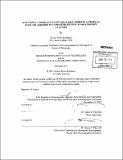Functional connectivity of coral reef fishes in a tropical seascape assessed by compound-specific stable isotope analyses
Author(s)
McMahon, Kelton Wells
DownloadFull printable version (12.96Mb)
Other Contributors
Woods Hole Oceanographic Institution.
Advisor
Simon R. Thorrold.
Terms of use
Metadata
Show full item recordAbstract
The ecological integrity of tropical habitats, including mangroves, seagrass beds and coral reefs, is coming under increasing pressure from human activities. Many coral reef fish species are thought to use mangroves and seagrass beds as juvenile nurseries before migrating to coral reefs as adults. Identifying essential habitats and preserving functional linkages among these habitats is likely necessary to promote ecosystem health and sustainable fisheries on coral reefs. This necessitates quantitative assessment of functional connectivity among essential habitats at the seascape level. This thesis presents the development and first application of a method for tracking fish migration using amino acid (AA) 13C analysis in otoliths. In a controlled feeding experiment with fish reared on isotopically distinct diets, we showed that essential AAs exhibited minimal trophic fractionation between consumer and diet, providing a 513C record of the baseline isoscape. We explored the potential for geochemical signatures in otoliths of snapper to act as natural tags of residency in seagrass beds, mangroves and coral reefs in the Red Sea, Caribbean Sea and Eastern Pacific Ocean. The 13C values of otolith essential AAs varied as a function of habitat type and provided a better tracer of residence in juvenile nursery habitats than conventional bulk stable isotope analyses (SIA). Using our otolith AA SIA approach, we quantified the relative contribution of coastal wetlands and reef habitats to Lutjanus ehrenbergii populations on coastal, shelf and oceanic coral reefs in the Red Sea. L. ehrenbergii made significant ontogenetic migrations, traveling more than 30 km from juvenile nurseries to coral reefs and across deep open water. Coastal wetlands were important nurseries for L. ehrenbergii; however, there was significant plasticity in L. ehrenbergii juvenile habitat requirements. Seascape configuration played an important role in determining the functional connectivity of L. ehrenbergii populations in the Red Sea. The compound-specific SIA approach presented in this thesis will be particularly valuable for tracking the movement of species and life-stages not amenable to conventional tagging techniques. This thesis provides quantitative scientific support for establishing realistic population connectivity models that can be used to design effective marine reserve networks.
Description
Thesis (Ph. D.)--Joint Program in Oceanography/Applied Ocean Science and Engineering (Massachusetts Institute of Technology, Dept. of Biology; and the Woods Hole Oceanographic Institution), 2011. Cataloged from PDF version of thesis. Includes bibliographical references (p. 147-166).
Date issued
2011Department
Joint Program in Oceanography/Applied Ocean Science and Engineering; Woods Hole Oceanographic Institution; Massachusetts Institute of Technology. Department of BiologyPublisher
Massachusetts Institute of Technology
Keywords
Joint Program in Oceanography/Applied Ocean Science and Engineering., Biology., Woods Hole Oceanographic Institution.